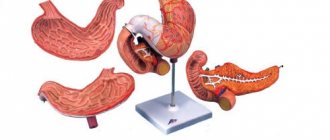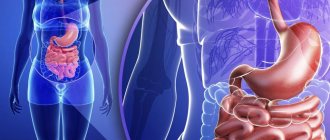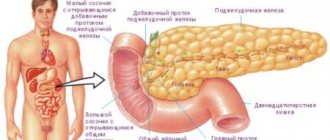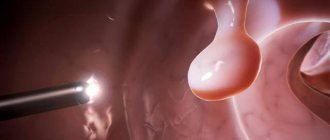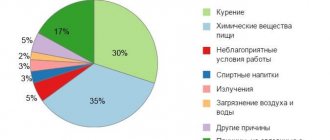Focal atrophic gastritis is the most dangerous of all gastric pathologies, a disease accompanied by severe inflammatory processes, disruption of the integrity of the gastric mucosa (GMU) and the synthesis of gastric secretions. With this form, the cells of the organ in which gastric secretion is produced are affected. As a result, necrosis of the glands begins and the synthesis of enzymes and hydrochloric acid responsible for digesting food is reduced. An advanced disease provokes processes of metaplasia of epithelial cells and the development of malignant neoplasms.
Classification of the disease
Focal atrophic gastritis, according to clinical signs, comes in 2 forms - acute and chronic. Acute gastritis with focal atrophy makes itself felt in a very short time - within a few hours or days. The symptoms are intense.
Chronic focal gastritis with atrophy manifests itself weakly or completely asymptomatically, the destruction of tissue and coolant occurs gradually over a long period of time.
According to the nature of the course of the disease, superficial, autoimmune, focal, hypertrophic, multifocal, atrophic and hyperplastic gastritis are distinguished:
- The simplest and most easily curable form of gastritis is superficial gastritis, which is also called catarrhal. With it, the lesion covers only the upper layers of the gastric mucosa. It is characterized by feelings of discomfort in the abdominal area, which disappear within a few days when following a diet.
- The autoimmune form of atrogastritis is accompanied by the production of antibodies that begin to attack the stomach’s own cells. This form occurs in 10% of cases.
- Focal atrophy of the gastric mucosa is a lesion in which atrophied foci alternate with hyperplasia (growth) of the skin tissue and secretory glands of the digestive organ. It is accompanied by increased production of hydrochloric acid in hypertrophied areas and the ph level of the epigastrium is disturbed.
- Hypertrophic gastritis is a special form of damage to gastric tissue with characteristic growths of the coolant with the formation of folds, polyps, warts and cysts. This type of gastritis is the most common.
- With the multifocal type of atrogastritis, necrotic tissue lesions are observed in various parts of the digestive organ with a decrease in the secretory activity of the organ.
- One of the dangerous types of atrogastritis is focal atrophic antral gastritis, when inflammation affects the antrum (outlet section of the stomach). Such a lesion causes a disruption in the synthesis of gastrin hormones, which are responsible for neutralizing hydrochloric acid. As a result, the acidity of the stomach sharply increases, which begins to corrode the mucous membrane of the stomach and duodenal intestine; single or numerous ulcerative lesions form in the organ. Signs of antrum gastritis may practically not appear, but they cause dangerous complications such as gastropathy (gastric and duodenal ulcers), heavy bleeding, and malignant tumors.
- Atrophic hyperplastic gastritis is a rare type of chronic atrophic gastritis, in which there is an abnormal increase in the size of the coolant. Some of the cells of the mucous walls begin to grow rapidly, destroying epithelial cells, the functioning of the gastric glands is disrupted, and the production of hydrochloric acid and enzymes that take part in the process of food processing decreases. Atrophic hyperplastic gastritis is provoked by Helicobacter pylori.
Important information: Methods for preventing gastritis
Causes of atrophic gastritis with low acidity
Most often, the appearance of this disease is associated with infection of the body by the bacterium Helicobacter pylori. Gastritis with low acidity is less common than with high acidity. It is more typical for people of mature age, prone to violations of the diet and quality of nutrition, as well as bad habits. However, you should be aware that the type of disease with high acidity can over time transform into a form with low acidity. This happens precisely because of atrophic processes on the gastric mucosa. Excess hydrochloric acid destroys the walls of the stomach with the glands located on them, which cease to function, the acidity decreases first to normal, and then below normal.
Low acidity - what is it?
The most important component of gastric juice is hydrochloric acid, which, in fact, is responsible for the digestion of food. Its concentration in the gastric juice is an indicator of acidity. If it is increased or decreased, the stomach functions differently, and an unpleasant and even dangerous disease appears - gastritis. If left untreated, the form of the disease becomes chronic.
If we are talking about atrophic gastritis, then low acidity is formed due to atrophy of the glands, which, as the disease progresses, lose their functionality, producing less hydrochloric acid and enzymes.
Let's consider a number of causes of this disease:
- eating disorders (frequent alternation of states of hunger and overeating, snacking on the go, non-compliance with the nutrition schedule);
- snacking on dry, unhealthy foods (fatty, spicy, smoked, etc.);
- bad habits (smoking, alcohol abuse, especially on an empty stomach);
- regular stress;
- uncontrolled use of medications;
- untreated gastritis;
- non-compliance with the diet and recommendations of the attending physician in the presence of any gastrointestinal diseases;
- the presence of chronic diseases of other organs (liver, kidneys, pancreas and thyroid glands, etc.).
Reasons for the development of pathology
In medical practice, the following reasons for the development of focal gastritis of the atrophic type have been noted:
- infection with pathogenic microorganisms - Helicobacter bacteria;
- abnormal immune system disorders;
- inflammatory processes in the pancreas, gall bladder, and intestines;
- alcohol abuse and smoking;
- disruption of the endocrine system;
- constant intoxication with harmful chemicals;
- infectious diseases of the gastrointestinal tract;
- taking “aggressive” medications;
- nervous fatigue and excessive physical exertion;
- heredity.
Treatment of gastritis with low acidity
For atrophic gastritis with low acidity, it is important to follow a complex of treatment. It includes a special therapeutic diet, drug therapy and additional treatment with folk remedies. This entire complex must be prescribed by the attending gastroenterologist.
Important! Treatment of atrophic gastritis is carried out under the supervision of a specialist: a gastroenterologist.
Drug treatment
Depending on the need, the following drugs are used:
- Antibiotics and anti-Helicobacter pylori agents are used for infection with the bacterium Helicobacter pylori (Metronidazole, Clarithromycin, Tinidazole, Amoxicillin, De-Nol, Ulcavis).
- Painkillers (“No-Shpa”, “Drotaverine”, “Papaverine”).
- Regenerating, enveloping and protecting the mucous membrane (De-Nol, Ulkavis, Almagel, Vikalin, Solcoseryl).
- Normalizing motor skills (“Trimedat”).
- Reducing (Omez, Omeprazole) or increasing (Acidin-Pepsin, Limontar, Etimazol) acidity.
- Enzyme replacement therapy drugs (Creon, Pancreatin, Mezim, Festal).
Treatment with folk remedies
To combat this type of gastritis, the following folk remedies are used:
- potato (relieves pain) and cabbage (heals mucous membranes) juices;
- decoction of flax seeds (well protects damaged mucous membranes);
- honey;
- green tea on an empty stomach;
- applesauce with lemon and honey on an empty stomach;
- infusion of parsley roots or plantain leaves;
- rosehip decoction;
- horseradish root;
- chamomile decoction with honey.
Many patients are interested in whether it is possible to completely cure atrophic gastritis? The answer is clear: this type of gastritis cannot be completely cured, but with proper and timely treatment, the atrophic processes can be stopped.
Additional treatment and healing methods
In addition to the above methods, treatment with mineral waters is common, which is carried out both in sanatoriums and at home. The attending physician selects the appropriate type, temperature and time of intake (before or after meals) of mineral water. Such properly selected treatment, as a rule, has no contraindications.
In addition, patients with this diagnosis are advised to engage in certain physical activity, as it stimulates the production of hydrochloric acid. Breathing exercises, walks in the fresh air, and gymnastic exercises that do not provide significant stress are recommended. All exercises are done to the best of your ability, without overload or sudden movements. They should not be performed in the acute stage or when feeling discomfort.
Important! There should be at least 1.5 hours between physical exercise (except for walking) and meals.
Symptomatic manifestations
Focal atrophic superficial gastritis has a long-term course, in which lesions begin from the gastric fundus and gradually cover the entire organ.
The early stage is characterized by the following signs:
- anemia due to poor absorption of iron and vitamin B12;
- mild pain in the stomach and abdomen;
- dull pain after eating;
- heartburn, belching, nausea and vomiting.
Iron and folic acid deficiency causes the following manifestations of general malaise:
- chronic lack of sleep;
- impotence;
- chronic fatigue;
- skin and mucous surfaces are bloodless;
- numbness of the tongue and change in its color;
- loss of sensation in the arms and legs;
- hair and nails are dry and brittle;
- breathing problems;
- chest pain;
- burning sensation in the mouth.
Later stages of gastric pathology manifest themselves as follows:
- the tongue is covered with a thick white coating, on which, when pressed, teeth marks remain;
- sour taste in the mouth;
- intense pain in the epigastric region;
- nausea and vomiting with the presence of undigested food debris, mucus and bloody discharge in the vomit;
- foul belching;
- bowel dysfunction;
- bloating and increased gas production;
- loss of appetite and weight loss.
Important information: Effective drugs for the treatment of gastritis
Diet for chronic conditions
Each form of gastritis has its own characteristics. Accordingly, the menu will have some differences. With prolonged inflammation of the stomach, it is important to increase the production of enzymes, since more often the pathology occurs with low acidity. In addition, you need to carefully monitor the level of incoming nutrients.
In a hospital setting, table No. 2 is assigned. It involves maximum removal of the load from the stomach. You can eat crushed food warm. Most of the menu should consist of boiled and steamed dishes. Occasionally you can cook in the oven. Fried and fatty foods, large amounts of spices and salt are completely excluded.
Diagnostic measures
During the initial examination, a gastroenterologist takes an anamnesis of the disease, studies all the symptoms and prescribes treatment based on the results of a comprehensive diagnosis.
Laboratory research:
- general blood and urine analysis;
- testing for antibodies and enzymes;
- blood testing and breath test for the presence of Helicobacter;
- ph-metry to determine the level of stomach acidity.
The following instrumental diagnostic methods are used:
- radiograph;
- endoscopy of the stomach to identify the lesion;
- fibrogastroduanoscopy, which allows you to determine the degree of ulcerative lesions of the stomach and duodenum;
- biopsy and histology;
- Ultrasound of the abdominal organs.
Based on all the tests, the doctor draws up a treatment regimen.
To avoid undesirable consequences, you should never begin to treat atrophic focal gastritis on your own.
Diagnosis of atrophic gastritis with low acidity
Based on symptoms and external signs, the atrophic form of gastritis is almost impossible to distinguish from another, therefore tests and instrumental diagnostics are necessary, which include:
- FGS with a biopsy of the affected mucosa, which most effectively determines the type of gastritis;
- determining the acidity level using a probe or a special capsule;
- X-ray of the stomach and duodenum;
- Ultrasound of the gastrointestinal tract.
A blood test can determine whether the patient's stomach contains the bacterium Helicobacter pylori.
Therapy for focal gastritis
Treatment of focal atrophic gastritis is carried out inpatiently, under strict medical supervision. The main emphasis is on prescribing medications in various areas:
- To destroy harmful bacteria, 3- or 4-phase treatment with antibiotics (Amoxicillin, Tetracycline, Clotrimazole, Metronidazole, etc.) is used.
- To restore secretory functions and gastric motility - Abomin, Acidin-Pepsin, Motilium, Cerucal, preparations from gastric juice.
- To help the stomach, enzyme preparations are prescribed - Pancreatin, Creon, etc.
- For anemia and vitamin deficiency, preparations containing iron, vitamin complexes, and vitamin B12 injections are used.
- To relieve pain - analgesics. To relieve spasms - antispasmodics (Drotaverine, No-shpa, Papaverine, Spazmolgon).
- To speed up the process of regeneration of gastric cells - cortecosteroids.
- Strengthening therapy - immunostimulants.
When treating stomach pathologies, nothing is more important than treating the disease through diet therapy. This method always has a good effect and positive reviews.
Important information: What is antral gastritis
The basic principle of proper nutrition for atrophic gastritis with focal lesions is a gentle diet aimed at facilitating gastric activity; inclusion in the diet of easily digestible foods containing fiber. Dishes are steamed or boiled and eaten in a well-chopped form. Fried, fatty, spicy, salty and sour foods, with various fillers and dyes, alcohol and carbonated drinks that can cause irritation of the coolant are strictly contraindicated.
In the acute form of atrogastritis - diet No. 1; during the period of remission, you can switch to diet No. 2.
Meals should be fractional, 5-6 times a day in small portions at a certain time. Food is consumed warm.
Treatment of focal atrophic gastritis
The treatment regimen for focal gastritis is similar to the treatment of mucosal inflammation in other types of this disease. It is based on a long-term diet, exercise and pharmacological agents. .
The following drugs are used:
- antibiotics,
- painkillers,
- regenerating mucous membranes,
- improving gastric motility,
- stimulating the production of hydrochloric acid,
- strengthening the immune system.
If the patient has severe pain, they are prescribed anticholinergics and antispasmodics, such as:
- "Methacin"
- "No-shpa"
- "Papaverine",
- "Drotaverine".
Nonsteroidal painkillers such as Ketanov cannot be used for gastritis. They will only worsen the inflammatory process.
The following will help improve the motility of the stomach and intestines:
- "Cerucal"
- "Trimedat"
- "Motilak"
- "Ganaton."
Expert opinion
Irina Vasilievna
Practicing gastroenterologist
If there is reduced acid production, Abomin, Pepsin or gastric juice helps compensate for it. If anemia occurs and vitamin deficiency develops, multivitamin complexes and iron supplements are prescribed.
If acidity is increased, the patient is recommended to take antacids (Rennie, Almagel) to restore the pH.
It is also recommended to take enzyme-containing drugs that promote better digestion of food. For gastritis, Creon, Mezim or Festal are prescribed. The drugs are included in the treatment regimen only at the stage of improvement of the patient's condition. In the acute phase they are contraindicated .
To restore the mucous membrane and cope with Helicobacter pylori, anti-inflammatory and antibacterial drugs “De-nol” or “Omeprazole”, as well as antibiotics, are used.
Therapy is prescribed only by a doctor, after an examination in accordance with the diagnosis. Self-medication of gastritis is dangerous because it worsens.
Folk remedies
Expert opinion
Irina Vasilievna
Practicing gastroenterologist
Traditional methods are used quite successfully in the treatment of mucosal lesions due to gastritis. Herbal medicine gives good results. Taking herbal decoctions begins after the exacerbation phase has passed. A decoction of chamomile, to which you can add lemon balm leaves, linden blossom, and fennel, has a healing, anti-inflammatory effect.
Potato and cabbage juice is considered an effective remedy .
They are prepared immediately before use. You need to drink no more than 50 ml of the drink before meals. Treatment is carried out for at least a month. Sea buckthorn oil heals and disinfects, stimulates intestinal motility.
The product is taken one spoon before meals for 2-3 months. Oatmeal jelly has an enveloping and softening effect. Take 2 tbsp per liter of water. l. And they insist for ½ day. The liquid is boiled, stirring. Drink before meals or as a separate snack, seasoned with honey.
As a remedy for heartburn, tincture of plantain (leaves) and chamomile is used. Place a spoonful of ground raw materials on a glass, keep it on fire for 3-5 minutes, then leave for a couple of hours.
Folk remedies are used only during remission and in consultation with the doctor.
Possible complications, prognosis
With adequate treatment, the prognosis is extremely favorable.
Incorrect treatment or late diagnosis of the disease leads to the fact that focal gastritis develops into ulcerative lesions of the mucous membrane.
The atrophic process is characterized by the death of the glands that produce gastric juice and digestive enzymes.
This entails serious disruptions in the process of processing and assimilation of incoming food. The consequence of this is vitamin deficiency and iron deficiency anemia. Chronic atrophic gastritis is often referred to by experts as a “harbinger of cancer.” The disease, which occurs with low acidity, ends in oncology in 15% of cases.
On our website: Fighting gastritis: 4 simple ways
ethnoscience
During the period when the symptoms of focal atrophic gastritis subside, treatment with folk remedies is encouraged, after consultation with the attending physician:
- Freshly squeezed potato and cabbage juices heal lesions of the gastric mucosa well. They are taken on an empty stomach. A herbal decoction of chamomile, linden, and mint will also help.
- Infusions of valerian roots, peony leaves, oregano and St. John's wort have a beneficial effect on the patient's nervous system.
- For stomach pain, it is possible to prescribe mint decoction, infusions of lemon balm, cyanosis, chamomile, oregano, and watch.
- High acidity is relieved by decoctions of calamus, knotweed, and calendula flowers.
- Marshmallow, licorice, elecampane, flax seeds, and plantain leaves have a good enveloping and healing effect.
Traditional therapy
Folk remedies are used in combination with drug therapy and only with the prescription of a specialist. Treatment with this method involves taking herbal decoctions that help normalize the secretion of gastric juice.
The most effective are drugs based on the following herbs and products:
- White cabbage juice. It is recommended to squeeze out just before use. You need to drink 2 tbsp. l. 25-35 minutes before meals. The juice of this vegetable can be replaced with potato juice.
- Green apple, chopped pumpkin and ¼ cup lemon juice. All ingredients are mixed, honey is added. It is recommended to consume the mixture in the morning on an empty stomach. After taking it, you should not eat anything else until lunch.
- A decoction of mint, St. John's wort, rose hips, plantain and chamomile. All ingredients are taken in equal quantities. Herbs are brewed for 3 hours. Take a decoction of 200-250 ml before meals (half an hour before).
If you have high acidity, experts recommend drinking mineral medicinal water, which can be purchased at any pharmacy or store. You need to drink 200-250 ml a couple of hours before and after meals.
Disease prevention
Compliance with basic rules will reduce the risk of developing focal atrophy of the coolant:
- follow a therapeutic diet and lead a healthy lifestyle with proper rest and 8 hours of sleep;
- exclude the use of alcoholic beverages and tobacco products;
- avoid psychological and physical fatigue;
- You should undergo an annual examination by a gastroenterologist;
- it is necessary to lead an active, mobile lifestyle;
- Treatment of gastrointestinal diseases must be timely and complete.
Contacting a specialist and qualified treatment will help you avoid the dangerous consequences of the disease.
Preventive actions
If the patient prevents focal gastritis or another form of stomach disease, it will be possible to avoid not only various complications, but also long-term therapy. In such a situation, it is recommended to carry out not only timely diagnosis, but also therapy; one should not allow the development of the chronic stage of the pathology. Patients also need to completely give up bad habits, such as smoking and frequent drinking of alcoholic beverages.
In any case, it is recommended to eat a healthy and balanced diet, and try to exclude harmful foods and dishes from your diet. The diet will help the whole body function properly and feel healthy. The daily routine should be rational, physical activity should be moderate. If the patient already suffers from gastritis, then every six months to a year it is worth undergoing a preventive examination with a gastroenterologist, taking all tests and following the recommendations, and taking medications if necessary.
Symptoms
First of all, with focal atrophic gastritis, a deterioration in appetite is manifested. In this regard, the patient begins to gradually lose weight. There are cases when pain symptoms due to inflammation of the gastric mucosa do not appear. This means that cell death has entered the active stage.
After some time, the patient begins to show dyspeptic symptoms of the disease. He begins to feel sick, and when gastritis worsens, the patient may vomit. Frequent belching, heartburn, and rumbling in the stomach occur. With this pathology, metabolic disorders occur in the body and increased gas formation in the digestive system. For this reason, the patient experiences bloating. He may show signs of diarrhea because the immune system is weakened and is more susceptible to various poisonings.
Subatrophic gastritis is characterized by a feeling of heaviness in the stomach after eating, and a very unpleasant and pungent odor in the oral cavity. The smell may resemble rotting. Due to metabolic disorders in the body, the patient’s appearance deteriorates. The skin becomes pale, the hair becomes dull, and the nails become brittle. This is usually due to a lack of vitamins and iron in the blood.
The following symptoms of focal atrophic gastritis are headache, sudden changes in pressure, anemia, and dizziness. A white or yellowish coating may be found on the tongue. With exacerbation of the symptoms of subatrophic gastritis, cholecystitis, enterocolitis, pancreatitis, and local necrosis may develop. Necrosis is the most dangerous pathology. To avoid serious consequences for the patient, it is necessary to promptly diagnose the gastrointestinal tract and determine a course of treatment.
Diffuse form
With diffuse gastritis, special attention is paid to diet. Damage in this pathology is superficial and timely treatment is a guarantee of high effectiveness. The diet for atrophic gastritis allows the appointment of table No. 2. In this case, the body will receive a sufficient amount of vitamins and at the same time the gastric mucosa will not experience stress.
You can eat pureed cereals, soups, baked and steamed foods. If there is inflammation with low acidity, you should supplement your diet with fruits and vegetables to improve motility. It is important that the food is warm and does not contain coarse fibers.
Menu for atrophic gastritis for a week
Dietary nutrition for inflammation of the stomach is carefully prepared, if not by a gastroenterologist, then by the patient. To do this, they take a ready-made menu option as a basis. Otherwise, no amendments are made to the compiled diet. The menu is planned for a week and used throughout the treatment.
- A common option for proper nutrition is to eat a steamed omelet with 1 piece of bran bread for breakfast on Monday. Drinks include berry or fruit compote. In the afternoon they eat vegetable salad. Cucumbers and tomatoes are suitable for this. At noon, eat steamed fish or boiled cereal. In the evening, it is recommended to eat low-fat cottage cheese and drink tea.
- The Tuesday morning table consists of salad with fruit. This dish is washed down with carrot juice (depending on the form and acidity of gastritis). Lunch consists of boiled or baked dietary fish. For lunch, prepare mashed potatoes with chicken. For dinner on this day you should eat vegetables.
- Wednesday morning begins with a breakfast of steamed eggs with vegetables. Wash down the dish with weak tea. The snack is made from fruit. Lunch consists of pumpkin puree soup. Boiled beef is added to the dish. For dinner, it is recommended to eat low-fat cottage cheese with fruit. They can be eaten together or separately.
- On Thursday, oatmeal is served for breakfast. For drinks, drink a glass of berry compote. This can be replaced with jelly. Baked fruits are prepared for lunch. Lunch should consist of vegetable soup or pasta. Meatballs serve as an additional dish. In the evening it is recommended to eat boiled fish with vegetables.
- On Friday morning, prepare a salad of tomatoes and cucumbers. Otherwise, replace it with a steamed omelette. Eat mashed potatoes as a snack. On this day you can drink a low-fat fermented milk product, kefir is suitable. For lunch they prepare buckwheat porridge with steamed cutlets. The evening meal consists of homemade yoghurt and bananas.
- For breakfast on Saturday they eat boiled fish. Drinks include weak green tea or rose hips. During lunch they make a vegetable salad. At lunchtime, eat soup made from permitted root vegetables. This dish is replaced with vegetable stew. Dinner consists of low-fat cottage cheese.
- On Sunday, banana and apple salad is prepared for breakfast. The snack consists of boiled chicken. They have lunch with rice and fish. Wash down food with weak tea. Dinner on Sunday evening is mashed potatoes with meatballs.
The dietary menu must be followed. You can make adjustments to it. It depends on the gastropathy and the type of atrophic gastritis. If treatment is not carried out correctly or recommendations are not followed, complications arise. These include erosive gastritis and stomach ulcers. In this case, the diet will be different. Exacerbation of gastritis occurs in women during pregnancy. This factor must be taken seriously.
Proper nutrition is also used in disease prevention. Recipes and approved products must be adjusted to the daily norm of the chemical composition.
We recommend: How to get rid of bad breath with gastritis?
